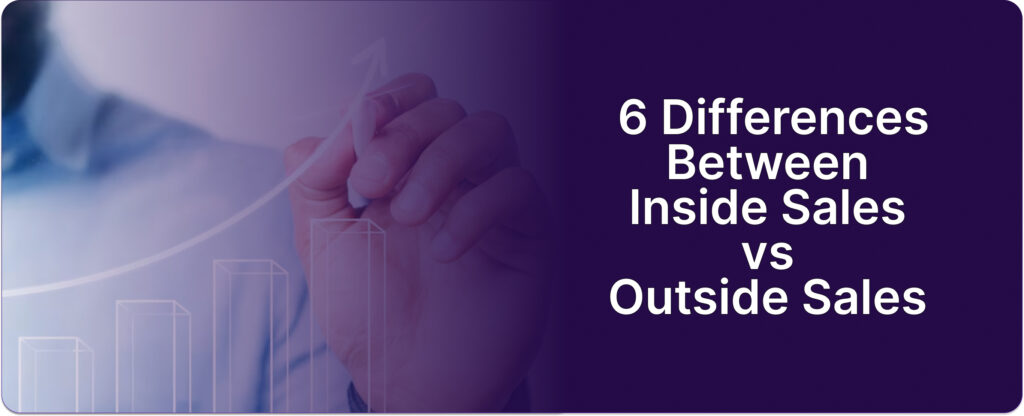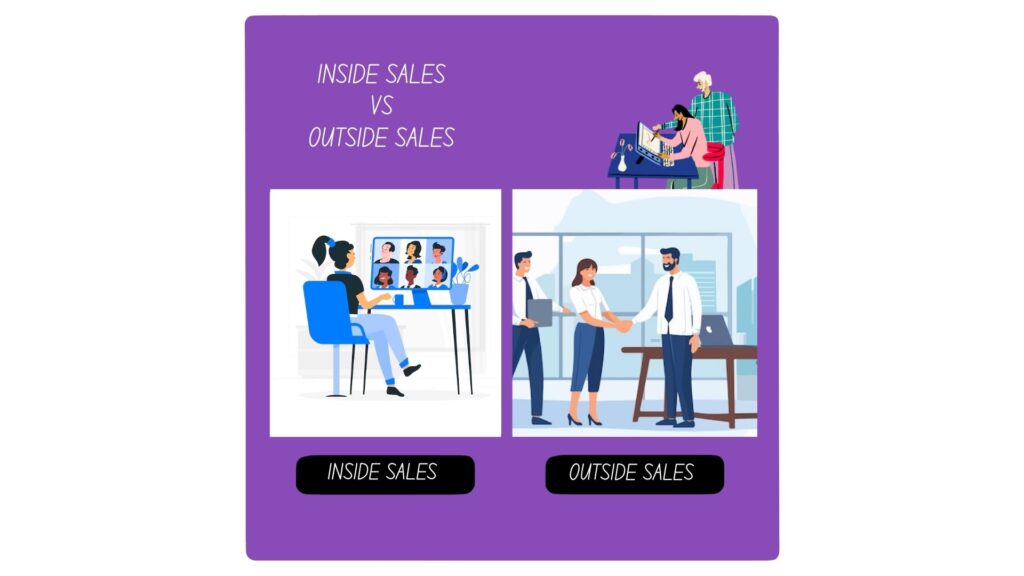
As per Zendesk, Inside sales processes are inherently more time- and cost-efficient than outside sales.
In this comprehensive blog post, we will explore inside sales vs outside sales, highlight their respective benefits, and provide actionable strategies to help sales teams excel.
Let’s dive in to find out the differences between Inside Sales vs Outside Sales
What is Inside sales vs Outside Sales?
Inside sales and outside sales are two distinct sales approaches, each with its strategies, roles, and objectives.
Inside sales refers to selling remotely, typically from an office or home setup, where sales representatives rely on digital communication channels such as phone calls, emails, and video conferencing to engage with potential clients.
In contrast, outside sales involve meeting clients face-to-face, with sales representatives often traveling to different locations to build relationships, demonstrate products, and close deals in person.

Inside Sales vs Outside Sales: Key Differences
Below are the top 6 differences between Inside Sales vs Outside Sales for sales trainers, and sales training managers to know about :
1. Inside Sales vs Outside Sales: Work Environment
One of the fundamental differences between inside sales and outside sales jobs is the work environment.
- Inside sales teams work remotely or in an office setting.
- Conducting sales primarily over the phone, email, or via video conferencing tools.
- Sales representatives use CRM systems, automation tools, and digital communication platforms to reach potential customers.
- Conversely, Outside sales professionals operate in the field.
- Engaging in face-to-face meetings with prospects and clients.
- They often travel to attend conferences, customer sites, and trade shows.
- This field-based approach allows outside sales reps to build personal relationships and rapport with clients through in-person interaction.
Key takeaway: Inside sales operate remotely, while outside sales rely heavily on in-person interactions and traveling.
2. Inside Sales vs Outside Sales: Sales Cycle Length
The sales cycle—the time it takes to convert a lead into a customer—also differs significantly between inside vs outside sales.
- Inside sales typically have shorter sales cycles.
- Since the interactions occur over digital channels, inside sales reps can reach out to more leads in a shorter time frame, providing information, setting meetings, and closing deals quicker.
- This process is often more transactional and suited for lower-ticket items or subscription services.
- On the other hand, Outside sales usually have longer sales cycles.
- Because the process involves scheduling in-person meetings, travel time, and the need to build deeper relationships, closing deals may take weeks or months.
- Outside sales are commonly used for higher-value products or services where trust and personal engagement are critical to the decision-making process.
Key takeaway: Inside sales tend to have shorter sales cycles, while outside sales typically involve longer, relationship-driven processes.
3. Inside Sales vs Outside Sales: Lead Generation Methods
Lead generation is a critical part of any sales strategy, and the methods used vary.
- Inside sales teams rely on digital marketing efforts to generate leads.
- These include cold calling, email marketing, social media outreach, and online ads.
- The use of CRM tools and marketing automation systems is essential to track prospects and streamline outreach efforts.
- Inside sales often capitalize on inbound leads generated from website visitors or downloadable content.
- Outside sales reps, on the other hand, often rely on more traditional lead generation methods.
- These include networking at industry events, referrals, attending trade shows, and scheduling in-person visits.
- Because outside sales reps focus on face-to-face interactions, they build trust through personal connections, which can be a crucial factor for closing deals in certain industries.
Key takeaway: Inside sales leverage digital tools for lead generation, while outside sales rely more on in-person networking and relationship building.
4. Inside Sales vs Outside Sales: Relationship Building
Another key difference between inside sales representative and outside sales representative is the level of personal relationship-building involved.
- Inside sales reps build relationships primarily through digital communication channels such as phone calls, video meetings, and email.
- While this can still foster good rapport, it’s harder to replicate the personal connection that comes from in-person meetings.
- Inside sales are more focused on efficiency and reaching larger numbers of prospects quickly.
- Outside sales, by contrast, are often driven by the strength of personal relationships.
- Face-to-face meetings allow outside sales reps to establish deeper connections, build trust, and better understand the client’s needs.
- This approach is especially valuable for high-stakes, complex, or large-scale deals, where long-term relationships are crucial to closing and retaining accounts.
Key takeaway: Inside sales focus on efficiency and remote relationships, while outside sales build stronger, personal connections through face-to-face interactions.
5. Inside Sales vs Outside Sales: Compensation Structure
The compensation structure for inside sales vs outside sales salary typically differs, reflecting the nature of the work and the types of deals each team handles.
- Inside sales reps often have a fixed salary with a commission based on the number of deals closed.
- Since the sales cycles are shorter and deal sizes are generally smaller, inside sales reps can close a higher volume of deals, resulting in a steady flow of commissions.
- Outside sales reps, however, usually have a higher commission structure due to the larger deal sizes they close.
- Their compensation may rely more on performance-based metrics, including commission rates that align with the lengthier sales cycles and the more significant revenue generated from each deal.
Key takeaway: Inside sales reps often have a steady salary plus commission, while outside sales reps may rely more on higher commissions tied to larger deals.
6. Inside Sales vs Outside Sales: Tools and Technology
Technology plays a significant role in both inside and outside sales, though the tools they rely on can differ.
- Inside sales teams are heavily reliant on technology to manage their day-to-day tasks.
- They use Customer Relationship Management (CRM) platforms, email automation tools, social media, and video conferencing tools like Zoom or Microsoft Teams to communicate with clients.
- These platforms help streamline processes, allowing inside sales reps to handle multiple leads efficiently.
- Outside sales reps also use CRM systems but often rely on mobile devices, apps, and tools that allow them to manage their work while traveling.
- They may use presentation tools, scheduling software, and even GPS-based tools to optimize their travel schedules.
- However, face-to-face meetings remain central to the outside sales process.
Benefits of Inside Sales vs Outside Sales
Lets look into the benefits of Inside Sales vs Outside Sales job:
Benefits of Inside Sales
1. Efficiency and Scalability
Inside sales teams can manage more leads and opportunities simultaneously, making it easier to scale operations.
2. Cost-Effectiveness
Since inside sales rely on virtual interactions. Businesses save on travel expenses, leading to a higher ROI.
3. Data-Driven Insights
Inside sales teams often use advanced CRM and automation tools that allow for real-time data collection. Enabling more informed decisions and strategy adjustments.
Benefits of Outside Sales
1. Stronger Relationships
Personal interactions in outside sales allow for deeper relationships with clients, which can be crucial for high-ticket, complex sales.
2. Trust and Rapport
Face-to-face meetings foster trust and rapport, which can significantly improve the likelihood of closing large deals.
3. Tailored Presentations
In-person meetings allow sales reps to tailor their presentations and pitches directly to the client’s unique needs and preferences.
Inside Sales vs Outside Sales: Effective Strategies
1. Technology and Tools
Inside Sales Strategies
- CRM Mastery: Inside sales reps should leverage customer relationship management (CRM) software like ConvoZen.AI to track real-time updates, enhancing productivity and customer engagement efficiently.
- Automation: Using automated email sequences, chatbots, and lead-scoring tools can help inside reps prioritize their outreach efforts and focus on the most qualified leads.
Outside Sales Strategies
- Virtual Selling Tools: Although they primarily focus on face-to-face interactions, outside sales teams should be familiar with video conferencing and digital contract signing tools, especially when travel isn’t possible.
- Territory Management Software: Optimizing travel routes and managing sales territories with the help of territory management software can significantly increase the efficiency of outside sales reps.
2. Lead Generation
Inside Sales Strategies:
- Inbound Marketing Alignment: Inside sales teams often work closely with marketing to generate and nurture leads through content marketing, SEO, and digital ads. A tight alignment between sales and marketing is crucial for success in inside sales.
- Cold Calling and Emailing: Inside sales reps can use cold outreach methods to build pipelines but should focus on personalizing their emails and calls to increase engagement rates.
Outside Sales Strategies:
- Networking and Events: Outside sales reps often rely on trade shows, conferences, and networking events to generate new leads. Building a strong presence at these events can significantly impact lead generation.
- Referral Programs: Outside sales teams benefit from referrals, leveraging existing relationships to expand their network and gain introductions to new prospects.
Conclusion
Inside Sales vs Outside Sales – Which is Right for Your Team?
Understanding the differences between inside sales and outside sales is critical for sales trainers and sales training managers when developing a comprehensive sales strategy. Inside sales are ideal for teams looking to handle high volumes, shorter sales cycles, and focus on leveraging technology to close deals remotely.
On the other hand, outside sales work best for building deep, long-term relationships, and managing more complex sales processes that benefit from face-to-face interactions.
By understanding the nuances between these two approaches, sales training managers can equip their teams with the right tools and skills to succeed in today’s competitive sales environment.
Need help refining your sales training strategy? Let ConvoZen.AI‘s sales analytics and coaching tools empower your inside and outside sales teams and streamline your call center operations with our call automation, webhooks, CRM, and email alerts. Experience seamless integration and real-time updates, enhancing productivity and customer engagement.
Contact us today to learn how we can help optimize your sales processes for maximum performance!
FAQs
B2B (Business-to-Business) sales can be either inside sales or outside sales, depending on the company’s approach.
An example of outside sales is a pharmaceutical representative who travels to hospitals and clinics to meet with doctors and promote medical products.
Inside sales representatives primarily work remotely via phone, and online communication tools, while outside sales representatives meet clients face-to-face for meetings and product demos.
Neither is inherently better, as the success depends on the type of business and sales strategy.
The salary for outside vs inside sales varies depending on industry and experience.
An Inside Sales Representative is responsible for reaching out to potential clients, managing customer relationships, and closing sales through phone calls.


